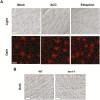Aminocyclopropane-1-carboxylic acid is a key regulator of guard mother cell terminal division in Arabidopsis thaliana
- PMID: 30462272
- PMCID: PMC6363092
- DOI: 10.1093/jxb/ery413
Aminocyclopropane-1-carboxylic acid is a key regulator of guard mother cell terminal division in Arabidopsis thaliana
Abstract
Stomata have a critical function in the exchange of gases and water vapor between plants and their environment. Stomatal development is under the rigorous control of many regulators. The last step of development is the terminal division of guard mother cells (GMC) into two guard cells (GC). It is still unclear how the symmetric division of GMCs is regulated. Here, we show that the ethylene precursor aminocyclopropane-1-carboxylic acid (ACC) is required for the symmetric division of GMCs into GCs in Arabidopsis. Exogenous application of the ACC biosynthesis inhibitor aminoethoxyvinylglycine (AVG) induced the formation of single guard cells (SGCs). Correspondingly, an acs octuple-mutant with extremely low endogenous ACC also developed SGCs, and exogenous ACC dramatically decreased the number of SGCs in this mutant whereas exogenous ethephon (which is gradually converted into ethylene) had no effect. Furthermore, neither blocking of endogenous ethylene synthesis nor disruption of ethylene signaling transduction could induce the production of SGCs. Further investigation indicated that ACC promoted the division of GMCs in fama-1 and flp-1myb88 mutants whereas AVG inhibited it. Moreover, ACC positively regulated the expression of CDKB1;1 and CYCA2;3 in the fama-1 and flp-1myb88 mutants. The SGC number was not affected by ACC or AVG in cdkb1;11;2 and cyca2;234 mutants. Taken together, the results demonstrate that ACC itself, but not ethylene, positively modulates the symmetric division of GMCs in a manner that is dependent on CDKB1s and CYCA2s.
Figures








Similar articles
-
Nitric oxide is involved in the regulation of guard mother cell division by inhibiting the synthesis of ACC.Plant Cell Environ. 2024 Aug;47(8):2716-2732. doi: 10.1111/pce.14734. Epub 2023 Oct 16. Plant Cell Environ. 2024. PMID: 37842726
-
Ethylene Inhibits Methyl Jasmonate-Induced Stomatal Closure by Modulating Guard Cell Slow-Type Anion Channel Activity via the OPEN STOMATA 1/SnRK2.6 Kinase-Independent Pathway in Arabidopsis.Plant Cell Physiol. 2019 Oct 1;60(10):2263-2271. doi: 10.1093/pcp/pcz121. Plant Cell Physiol. 2019. PMID: 31241163
-
Requirement for A-type cyclin-dependent kinase and cyclins for the terminal division in the stomatal lineage of Arabidopsis.J Exp Bot. 2014 Jun;65(9):2449-61. doi: 10.1093/jxb/eru139. Epub 2014 Mar 31. J Exp Bot. 2014. PMID: 24687979 Free PMC article.
-
1-Aminocyclopropane 1-Carboxylic Acid and Its Emerging Role as an Ethylene-Independent Growth Regulator.Front Plant Sci. 2019 Dec 5;10:1602. doi: 10.3389/fpls.2019.01602. eCollection 2019. Front Plant Sci. 2019. PMID: 31921251 Free PMC article. Review.
-
Something old, something new: Conservation of the ethylene precursor 1-amino-cyclopropane-1-carboxylic acid as a signaling molecule.Curr Opin Plant Biol. 2022 Feb;65:102116. doi: 10.1016/j.pbi.2021.102116. Epub 2021 Oct 13. Curr Opin Plant Biol. 2022. PMID: 34653952 Review.
Cited by
-
Ethylene biosynthesis in legumes: gene identification and expression during early symbiotic stages.J Exp Bot. 2025 Jul 2;76(10):2659-2672. doi: 10.1093/jxb/eraf069. J Exp Bot. 2025. PMID: 39969186 Free PMC article.
-
Ethylene, ACC, and the Plant Growth-Promoting Enzyme ACC Deaminase.Biology (Basel). 2023 Jul 25;12(8):1043. doi: 10.3390/biology12081043. Biology (Basel). 2023. PMID: 37626930 Free PMC article. Review.
-
Deciphering morphological and biochemical modulations in mungbean by application of ethylene precursor and inhibitors under cadmium stress.Sci Rep. 2025 May 1;15(1):15294. doi: 10.1038/s41598-025-96375-y. Sci Rep. 2025. PMID: 40312526 Free PMC article.
-
Co-expression network and comparative transcriptome analysis for fiber initiation and elongation reveal genetic differences in two lines from upland cotton CCRI70 RIL population.PeerJ. 2021 Jul 21;9:e11812. doi: 10.7717/peerj.11812. eCollection 2021. PeerJ. 2021. PMID: 34327061 Free PMC article.
-
Editorial: Physiological Aspects of Non-proteinogenic Amino Acids in Plants.Front Plant Sci. 2020 Dec 17;11:519464. doi: 10.3389/fpls.2020.519464. eCollection 2020. Front Plant Sci. 2020. PMID: 33391293 Free PMC article. No abstract available.
References
-
- Alonso JM, Hirayama T, Roman G, Nourizadeh S, Ecker JR. 1999. EIN2, a bifunctional transducer of ethylene and stress responses in Arabidopsis. Science 284, 2148–2152. - PubMed
-
- Balcerowicz M, Ranjan A, Rupprecht L, Fiene G, Hoecker U. 2014. Auxin represses stomatal development in dark-grown seedlings via Aux/IAA proteins. Development 141, 3165–3176. - PubMed
-
- Bergmann DC, Sack FD. 2007. Stomatal development. Annual Review of Plant Biology 58, 163–181. - PubMed
Publication types
MeSH terms
Substances
LinkOut - more resources
Full Text Sources
Medical
Molecular Biology Databases
Miscellaneous

